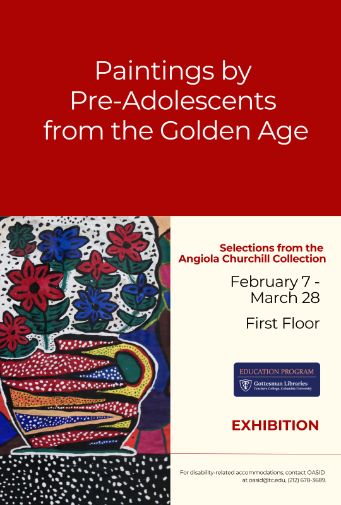New Exhibit: Paintings by Pre-Adolescents from the Golden Age
First Floor
Angiola Churchill (b. 1922), an Artist and Art Educator, was Professor Emeritus of New York University and former Chair of the Department of Art and Arts Professions, 1975-2005. She was the Founder/Director of the New York University studio art program in Venice, 1974-2006; and co-director of the International Center for Advanced Studies in Art. She has had numerous one-person exhibitions and participated in more than 54 group shows, biennials, and art fairs. Angiola earned her Ed.D in 1967; her dissertation, under advisement from Justin Schorr and Dwayne Huebner, is entitled, Painting for the Preadolescent : A Guide Book for the Prospective Teacher. She taught in the Program at Teachers College, Columbia University from 1996-2006, and is author of the classic text Art for Pre-Adolescents (New York, McGraw-Hill, [1971]).
These paintings were collected as part of Angiola Churchill’s research into the creative potential and personality of pre-adolescents, baby boomers who set paint to paper to capture their understanding of themselves and world around them – in the country, city, in industry and nature. Striking is their use of shape, line, color, texture, and movement which are telling of the nature of the painting and the nature of the child.
In her dissertation, Angiola remarked that “painting has special potentiality for the pre-adolescent, whose needs and growing skills can be geared to the process with good effects on personality, ego strength, sense of identity, and security. Whether or not he becomes an artist, the painting experience has a correlation with the child’s general education and may affect later adjustment in life.” (p.3, Painting for the Preadolescent : A Guide Book for the Prospective Teacher).
Created in the 1950s and 1960s from different countries, including Japan, Italy, and the United States, the works were donated to the Library of Teachers College in the early 2000s. While we know very little about the artists, it is understood that international relations following World War II would take time to rebuild. Postwar decades would usher in America’s “Golden Age” – a time of prosperity and social change that would lead into a period of social disruption or activism, known as the Civil Rights Movement, a movement that would have repercussions throughout Asia and Europe in urging equality, justice, and self-determination.
This exhibit is made possible through the continuing generosity of the Myers Foundations.
Where: First Floor
When: February 7th - March 28th

Poster Image:
Artist, Title, and Date Unknown, from the Angiola Churchill Collection, Courtesy of Teachers College, Columbia University.

